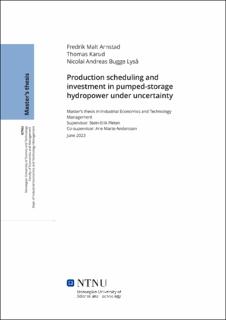| dc.contributor.advisor | Fleten, Stein-Erik | |
| dc.contributor.advisor | Andersson, Ane Marte | |
| dc.contributor.author | Arnstad, Fredrik Malt | |
| dc.contributor.author | Karud, Thomas Bruun | |
| dc.contributor.author | Lyså, Nicolai Andreas Bugge | |
| dc.date.accessioned | 2024-01-16T18:19:35Z | |
| dc.date.available | 2024-01-16T18:19:35Z | |
| dc.date.issued | 2023 | |
| dc.identifier | no.ntnu:inspera:146857327:153149983 | |
| dc.identifier.uri | https://hdl.handle.net/11250/3111988 | |
| dc.description.abstract | I en fremtid med høy andel fornybar elektrisitet vil et magasinbasert vannkraftverk med pumpefunksjon være etterspurt for å kunne levere mot-syklisk kraft. I denne oppgaven presenterer vi et beslutningsrammeverk for å beregne optimal tidspunkt for investering i et pumpekraftverk. Beslutningsrammeverket er støttet av en detaljert produksjonsplanlegger spesifikt utviklet for pumpekraftverk. Planleggeren bruker en to-trinns stokastisk lineær programmering implementert med en rullerende intrinsisk metode. Produksjonen planlegges med høy presisjon, der produksjonsbeslutninger for alle timer i en ettårig planleggingsperiode tas. Vi formulerer investeringsproblemet som et optimalt stoppeproblem, med en kostnadsfunksjon avhengig av produksjonskapasitet og en verdivurdering basert på produksjonsplanleggeren. Våre resultater indikerer at pumpelagringskraftverk kan være svært lønnsomme gitt markedsvolatiliteten i moderne kraftmarkeder med åpen handel. | |
| dc.description.abstract | In a future with high shares of renewable electricity sources, the ability of reservoir hydropower to provide counter-cyclical power will be in high demand. The inclusion of a pump, converting a hydropower facility to a pumped storage facility will increase this ability further. In this thesis, we present a decision framework for calculating the optimal time to invest in a pumped storage hydropower facility. The framework is supported by a detailed production scheduler, specifically modelled for pumped storage hydropower. The scheduler is implemented as a two-stage stochastic linear program in a rolling intrinsic method. Production is scheduled with high precision, with a production decision for all hours within a one-year planning period. We formulate the investment problem as an optimal stopping problem, with an upgrade-dependent cost function and a plant valuation based on the production scheduler. Our results indicate that, given the market volatility in modern openly traded power markets, pumped storage facilities could be highly profitable. | |
| dc.language | eng | |
| dc.publisher | NTNU | |
| dc.title | Production scheduling and investment in pumped-storage hydropower under uncertainty | |
| dc.type | Master thesis | |
